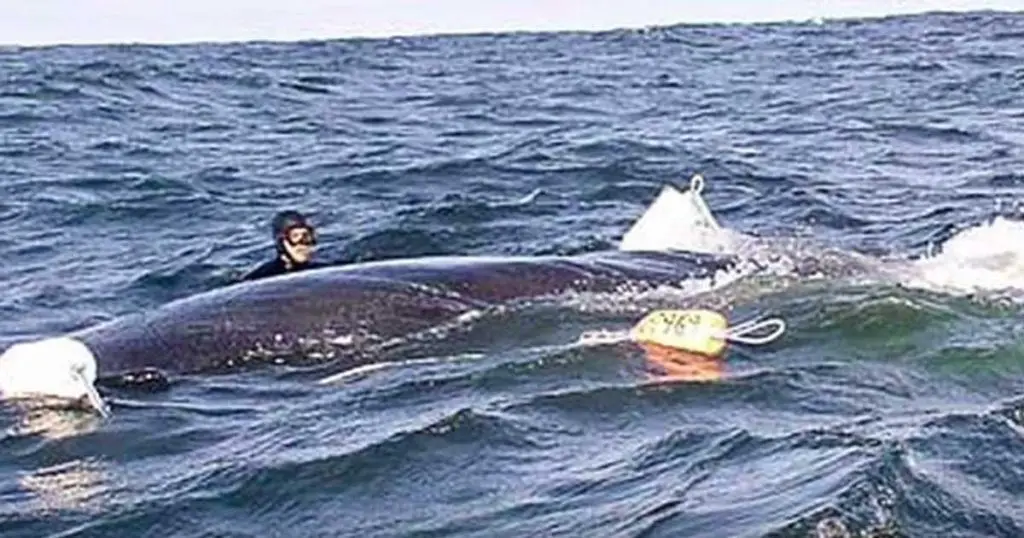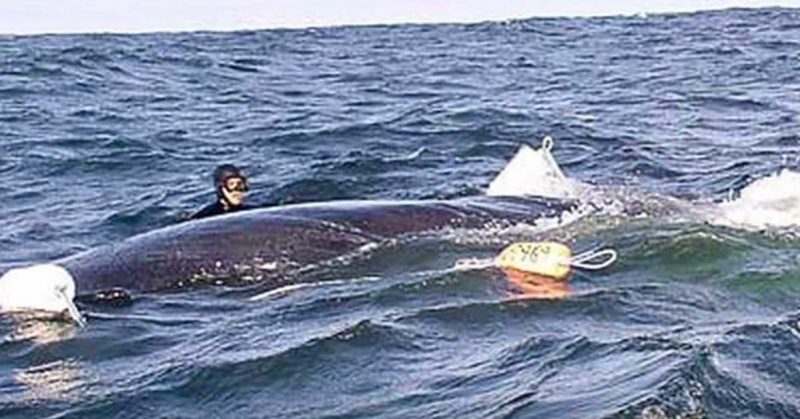In 2012, professional diver James Moskito encountered a whale in distress while on a tour with a group of volunteers by the Farallon Islands, off the coast of San Francisco. [1] Moskito’s excitement at the sight of a magnificent humpback whale immediately turned to worry when he noticed something wasn’t right. The whale was spending too much time on the surface, an activity that’s uncharacteristic of the species.
With an average weight of 25–30 metric tons (the size of a fully-loaded fire truck), these mammals don’t usually hang around or sail on the surface after a breach. Whales forcefully breach the water surface, leaping into the air for a few moments before diving back down. However, this particular humpback was acting strangely, as though it was in distress, and Moskito knew he had to help.

“I remember it like it was just a few minutes ago. The whale came up on a breath, put its eyes above the surface, and I could tell it was looking at me. It just stayed there,” he narrated.
Discarded fishing equipment had seriously injured the animal

When Moskito got close to the whale, he soothingly spoke to it. “I’m here to help you. I’m not gonna hurt you.”
He examined the poor thing and discovered the cause of its distress: It had gotten caught up in the ropes of a 3,000-pound anchor, often called “blue steel,” a testament to its brash strength. It’s mostly used by fishermen but in this scenario, it was used by crabbers to attach traps to buoys at the bottom of the ocean, and subsequently dumped or forgotten in the water.
The whale had gotten so wound up in the chains that it had a line running through its mouth. It was also being weighed down by 3,000 pounds of steel and battling incredible pain.
For over five hours, James and the other divers worked to free the whale. He explained that the animal was cooperative, holding its mouth open long enough for the divers to pull pieces of rope out of it one by one. When they finally removed the section wound around the tail, the animal was set free.
A hearty display on intense gratitude
The relieved whale didn’t hold back in showing its rescuers just how grateful it was for the kind gesture.
Moskito said, “The whale at that point started moving around us, swimming in circles, swimming right next to us, rubbing us, and then it dove down. Looking down in the water, the next thing I know, I have this whale coming right up at me. It was like a small moving bus coming right at me, and it literally stopped six inches from my chest. It nudged me forward like your household dog does when it wants to be petted, and then it turned on its side and put its eye right next to me and looked. I started petting her again and it was definitely a feeling of affection.”
Whales, while still dangerous when threatened, are sweetly emotional and can often be friendly. Humpbacks are known to be the most playful whales on earth, and are even famous for “singing.”
The whale was able to share an affectionate moment with Moskito because it has similar emotional traits to humans.
According to a 2006 study conducted by researchers in New York, “Whales may share our kind of intelligence, researchers say after discovering brain cells previously found only in humans and other primates. They were touted as the brain cells that set humans and the other great apes apart from all other mammals. Now it has been discovered that some whales also have spindle neurons — specialized brain cells that are involved in processing emotions and helping us interact socially.”
If the divers hadn’t been around to rescue the whale, it would have only been a matter of time before it gave up the struggle. Hundreds of thousands of marine animals are killed every year in the oceans and seas by discarded equipment and fishing gear. Reports state that over 640,000 tons of fishing equipment are abandoned or discarded in the world’s seas and oceans every year, [2] Aquatic animals would often be entangled, suffocated, or poisoned by these items, some of which may take hundreds to thousands of years to decompose.
A possible solution to this problem is the mandatory tagging of fishing gear for easy tracking of perpetrators. Using chemical marking, color coding, or RFID, all types and materials of fishing gear should be tagged by manufacturers to aid investigations and discourage fishermen from abandoning gear in the water. [3]
These precious marine animals must be protected in their natural habitats and us humans are responsible for their safety.
References
- “Whale Thanks Diver For Saving Him.” Shareably. Ashley Brewer. Retrieved July 28, 2020.
- “640,000 Metric Tons of Ghost Gear Enters Oceans Each Year.” Eco Watch. Lorraine Chow. Retrieved July 28, 2020.
- “To stop the deaths of countless marine animals, we need to tag fishing gear.” World Animal Protection. Retrieved July 28, 2020.
- “Whales boast the brain cells that ‘make us human’.” New Scientist. Andy Coghlan. Retrieved July 28, 2020.

